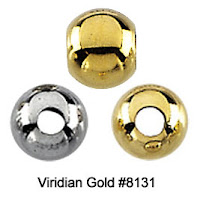Sterling Silver--a great choice for jewelry!
 Because of soaring gold and platinum metal prices, lots of folks are re-thinking sterling silver jewelry. Since silver is the standard by which metal whiteness is measured, a sterling silver ring will look great on your finger, and no one will know it's not platinum! Because silver is much less expensive than gold (and is only slightly less dense than 14K gold), a silver ring can be made with more of the metal, giving it good "heft" and feel. At Viridian Gold, we also have many items which combine sterling silver and 14K gold, such as our Silver & Gold Cross Ring and our Silver & Gold Amethyst Cuff Bracelet, just to name a few!
Because of soaring gold and platinum metal prices, lots of folks are re-thinking sterling silver jewelry. Since silver is the standard by which metal whiteness is measured, a sterling silver ring will look great on your finger, and no one will know it's not platinum! Because silver is much less expensive than gold (and is only slightly less dense than 14K gold), a silver ring can be made with more of the metal, giving it good "heft" and feel. At Viridian Gold, we also have many items which combine sterling silver and 14K gold, such as our Silver & Gold Cross Ring and our Silver & Gold Amethyst Cuff Bracelet, just to name a few! Silver items will tarnish, of course, but many silver jewelry items are worn close to the skin, such as pendants and rings, and these items tend to stay tarnish-free on most people. If not exposed to harsh chemicals (such as pool chlorine or sulfur), these items will rarely need polishing. Other types of silver jewelry that are not worn daily, such as earrings or pins, will need to be polished periodically (unless they are plated with rhodium, see below)--they will also benefit by being stored in a tarnish-inhibiting cloth or jewelry box. And, some folks seem to have a skin chemistry that just does not agree with silver, perhaps because of diet or general body chemistry, so they will need to polish their silver jewelry more often.
Silver items will tarnish, of course, but many silver jewelry items are worn close to the skin, such as pendants and rings, and these items tend to stay tarnish-free on most people. If not exposed to harsh chemicals (such as pool chlorine or sulfur), these items will rarely need polishing. Other types of silver jewelry that are not worn daily, such as earrings or pins, will need to be polished periodically (unless they are plated with rhodium, see below)--they will also benefit by being stored in a tarnish-inhibiting cloth or jewelry box. And, some folks seem to have a skin chemistry that just does not agree with silver, perhaps because of diet or general body chemistry, so they will need to polish their silver jewelry more often. It's easy to polish a silver neck-cross or silver ring: simply use your own toothpaste, rubbing it over the item with your fingers and then rinsing it off. It's quick and cheap! The same materials that polish your teeth will gently remove the tarnish, leaving alone the darker recesses of the design. But, don't ever polish any sterling silver items that are rhodium plated! That's because the polish will remove the rhodium (which does not tarnish) and expose the silver, allowing it to eventually tarnish.



Comments